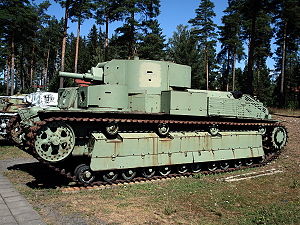| T-28 | |
|---|---|
 T-28E registered as R-48, since 1943 Ps. 241–4,[1] at the Parola Tank Museum in Finland | |
| Type | Medium tank |
| Place of origin | Soviet Union |
| Service history | |
| In service | 1933–45 |
| Used by | Soviet Union |
| Wars | Soviet invasion of Poland, Winter War, World War II, Continuation War |
| Production history | |
| Designed | 1931 |
| Produced | 1932–41 |
| No. built | 503 |
| Variants | T-28E, T-28 Model 1940, OT-28 |
| Specifications | |
| Mass | 28 tonnes |
| Length | 7.44 m (24 ft 5 in) |
| Width | 2.87 m (9 ft 5 in) |
| Height | 2.82 m (9 ft 3 in) |
| Crew | 6 |
| Armour | 20–40 mm (0.79–1.57 in) |
Main armament | 76.2 mm KT-28 howitzer (70 rounds) |
Secondary armament | 4 or 5×7.62 mm DT machine guns (8,000 rounds) |
| Engine | 46.9 L Mikulin M-17 V12 engine 500 hp (370 kW) |
| Power/weight | 18 hp/t (13 kW/t; 16 hp/ST) |
| Suspension | plunger suspension with twin bogies |
Operational range | 220 km (140 mi) |
| Maximum speed | 43.5 km/h (27.0 mph) |
The T-28 was a Soviet multi-turreted medium tank. The prototype was completed in 1931, and production began in late 1932. It was an infantry support tank intended to break through fortified defences. The T-28 was designed to complement the heavier T-35 (also multi-turreted), with which it shared turret designs. The type did not have great success in combat, but it played an important role as a development project for Soviet tank designers. A series of new ideas and solutions that were tried out on the T-28 were later incorporated in future models.
- ^ "Finnish World War II Armour". Andreas Lärka. Archived from the original on 9 December 2012. Retrieved 9 March 2013.